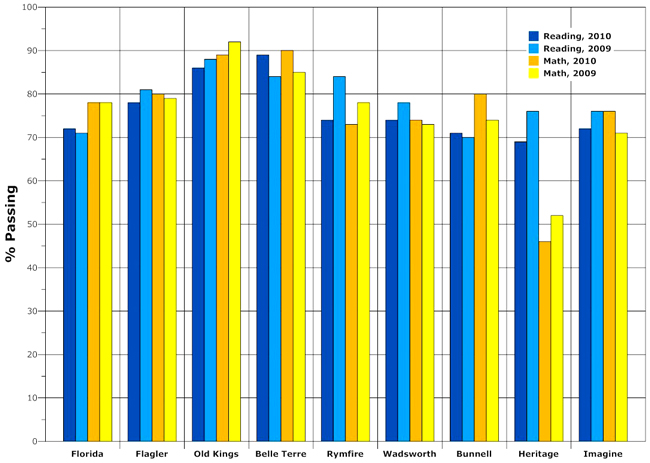
Of the 1,040 Flagler County third graders who took the reading portion of the Florida Comprehensive Assessment Test last spring, 79 percent scored a 3 or better on the test’s 5-point scale. A 3 means they can read at grade level. Last year’s 3rd graders did slightly better: 81 percent scored at least a 3. The rate is still well above the state’s 72 percent.
Flagler ranks 20th out of 67 counties in 3rd graders’ reading proficiency. The county ranks 33rd in math proficiency. (For a complete chart breaking down scores by school and proficiency level, go here.)
Belle Terre Elementary’s 3rd graders showed the biggest improvement in reading over their predecessors, going from a total success rate of 74 percent to 79 percent. Belle Terre’s 79 percent is also the highest in the county in reading. Bunnell Elementary’s 3rd graders improved by one point. All other schools showed declines, most severely at Rymfire Elementary, where the success rate dropped from 84 to 74.
Rymfire has been the school most severely affected by a transitory student population as families coping with job losses and foreclosures have been rendered homeless or been forced to move out of the county. Unstable student populations in a school tend to hurt class performance, including on standardized tests.
The worst-performing school in the county, however, is Heritage Elementary, a charter school with just 13 students tested, and a rate of 3 or better in reading of 69 percent, a drop from last year’s 76 percent. In math, just 46 percent of heritage’s students scored 3 or better. Imagine School, another charter school, had a reading success rate of 72 percent and a math success rate of 76 percent.
This year, 115 students scored 1 on the reading portion of the FCAT, or 11 percent of the county’s 3rd graders—the same proportion that failed the test last year. Students scoring 2 on the FCAT reading portion will still be promoted to the 4th grade. Students scoring 1 won’t be, unless they attend a summer reading program and pass yet another standardized test, the Stanford 9.
District-wide in reading, 37 percent of students scored achieved level 3, 33 percent scored 4, and 9 percent scored 5.
Math scores improved by two points district-wide, from 79 percent of students earning 3 or more last year to 81 percent this year. Again, Belle Terre Elementary has the highest overall success rate in math, with 90 percent showing proficiency there, an improvement from last year’s 85 percent. Bunnell Elementary’s 3rd graders showed a slightly steeper improvement, going from 74 percent to 80 percent.
Those improvement rates are critical for schools, because they factor disproportionately into the school’s eventual overall grade and dictate whether that school qualifies for bonus money. In 2008, Flagler was the only Florida school district where every traditional public school (not counting charter schools) scored an A. That had never happened in any district in Florida before. Last year, Rymfire and Wadsworth elementaries and Matanzas High School got B’s. Flagler Palm Coast High School dropped to a D.
An important word of caution with FCAT scores: comparing one class against another can be statistically sensational, but as a matter of educational, and educated, information, it’s an almost useless comparison as the sets of students and the circumstances surrounding those students are vastly different one from another. Comparisons between one class and another distort individuals student achievement (or learning issues with individual students) while playing up a false sense of competition between grades–and schools. That’s one of the many reasons teachers and principals, who are closer to their students than politicians or the FCAT’s state administrators, eye FCAT results skeptically.





























Merrill says
These results show clearly that School Choice works–as long as the choice is a Public School! Why is so much time, effort, energy and attention, not to mention money, being wasted on these efforts to produce what has proven to be mediocre outcomes?
Kevin says
Too bad the same can’t be said for public schools in many other locations when competing against private or charter schools.